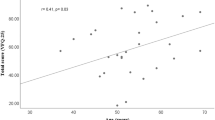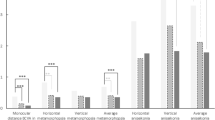Abstract
Purpose
Quantifying the subjective impairment due to floaters based on an indication-specific questionnaire and setting its change between prior to and 3/12 months after elective vitrectomy in relation to surgical risks.
Methods
Single-arm longitudinal observational multicenter study. Sixty-four floater patients underwent 23G pars plana vitrectomy; simultaneous phacoemulsification was excluded. An overall self-rated impairment index (SRI) and sub-indices SRI were calculated on the basis of a modified Visual Quality of Life questionnaire (VQoL), which addresses general vision, glare, near-sight problems and mobility of floaters. SRI ranged from 0 to 100% (maximum impairment). Secondary endpoints included corrected visual acuity and complications.
Results
Data were collected prior to and 3 (n = 64) and 12 (n = 62) months after surgery. The median overall SRI improved (44, 12, 11%) with a statistically significant median reduction of 69% (95% confidence interval 50–89%) 3 months postop. The median sub-SRIs improved for glare (50, 17, 17%), near sight problems (50, 17, 8%), and mobility of floaters (43, 5, 0%). Sixteen eyes needed cataract surgery during follow-up (10 showed cataract already prior to vitrectomy). Eight complications were reported (6 intra-operative retinal holes, 2 post-operative retinal detachments).
Conclusion
For the majority of floater patients, subjective impairment was profoundly reduced by vitrectomy. Benefits of surgery prevailed despite complications.
Similar content being viewed by others
References
Milston R, Madigan MC, Sebag J (2016) Vitreous floaters: etiology, diagnostics, and management. Surv Ophthalmol 61(2):211–227. https://doi.org/10.1016/j.survophthal.2015.11.008
Sebag J (1989) The vitreous—structure, function an pathobiology. Springer-Verlag, New Yor
Serpetopoulos CN, Korakitis RA (1998) An optical explanation of the entoptic phenomenon of ‘clouds’ in posterior vitreous detachment. Ophthalmic Physiol Opt 18(5):446–451
Sebag J, Yee KM, Wa CA, Huang LC, Sadun AA (2014) Vitrectomy for floaters: prospective efficacy analyses and retrospective safety profile. Retina 34(6):1062–1068. https://doi.org/10.1097/IAE.0000000000000065
Wagle AM, Lim WY, Yap TP, Neelam K, Au Eong KG (2011) Utility values associated with vitreous floaters. Am J Ophthalmol 152(1):60–65 e61. https://doi.org/10.1016/j.ajo.2011.01.026
Koo EH, Haddock LJ, Bhardwaj N, Fortun JA (2016) Cataracts induced by neodymium-yttrium-aluminium-garnet laser lysis of vitreous floaters. Br J Ophthalmol https://doi.org/10.1136/bjophthalmol-2016-309005
Cowan LA, Khine KT, Chopra V, Fazio DT, Francis BA (2015) Refractory open-angle glaucoma after neodymium-yttrium-aluminum-garnet laser lysis of vitreous floaters. Am J Ophthalmol 159(1):138–143. https://doi.org/10.1016/j.ajo.2014.10.006
Mason JO 3rd, Neimkin MG, JOt M, Friedman DA, Feist RM, Thomley ML, Albert MA (2014) Safety, efficacy, and quality of life following sutureless vitrectomy for symptomatic vitreous floaters. Retina 34(6):1055–1061. https://doi.org/10.1097/IAE.0000000000000063
de Nie KF, Crama N, Tilanus MA, Klevering BJ, Boon CJ (2013) Pars plana vitrectomy for disturbing primary vitreous floaters: clinical outcome and patient satisfaction. Graefes Arch Clin Exp Ophthalmol 251(5):1373–1382. https://doi.org/10.1007/s00417-012-2205-3
Schulz-Key S, Carlsson JO, Crafoord S (2011) Longterm follow-up of pars plana vitrectomy for vitreous floaters: complications, outcomes and patient satisfaction. Acta Ophthalmol https://doi.org/10.1111/j.1755-3768.2009.01682.x
Tan HS, Mura M, Lesnik Oberstein SY, Bijl HM (2011) Safety of vitrectomy for floaters. Am J Ophthalmol 151(6):995–998. https://doi.org/10.1016/j.ajo.2011.01.005
Hoerauf H, Muller M, Laqua H (2003) Vitreous body floaters and vitrectomy with full visual acuity. Ophthalmologe 100(8):639–643. https://doi.org/10.1007/s00347-002-0766-y
Schiff WM, Chang S, Mandava N, Barile GR (2000) Pars plana vitrectomy for persistent, visually significant vitreous opacities. Retina 20(6):591–596
Frost NA, Sparrow JM, Durant JS, Donovan JL, Peters TJ, Brookes ST (1998) Development of a questionnaire for measurement of vision-related quality of life. Ophthalmic Epidemiol 5(4):185–210
Cohen MN, Rahimy E, Ho AC, Garg SJ (2015) Management of symptomatic floaters: current attitudes, beliefs, and practices among vitreoretinal surgeons. Ophthalmic Surg Lasers Imaging Retina 46(8):859–865. https://doi.org/10.3928/23258160-20150909-11
Castilla-Marti M, van den Berg TJ, de Smet MD (2015) Effect of vitreous opacities on straylight measurements. Retina 35(6):1240–1246. https://doi.org/10.1097/IAE.0000000000000456
Qiao L, Wan X, Cai X, Vasudevan B, Xiong Y, Tan J, Guan Z, Atchison DA, Wang N (2014) Comparison of ocular modulation transfer function determined by a ray-tracing aberrometer and a double-pass system in early cataract patients. Chin Med J 127(19):3454–3458
Garcia GA, Khoshnevis M, Yee KM, Nguyen-Cuu J, Nguyen JH, Sebag J (2016) Degradation of contrast sensitivity function following posterior vitreous detachment. Am J Ophthalmol https://doi.org/10.1016/j.ajo.2016.09.005
Feng H, Adelman RA (2014) Cataract formation following vitreoretinal procedures. Clin Ophthalmol 8:1957–1965. https://doi.org/10.2147/OPTH.S68661
Acknowledgments
The authors thank Dr. NA Frost for the permission to use the Visual Quality of Life questionnaire for developing the Floaters questionnaire. Furthermore, the authors are grateful to Mrs. Nicole Waack for study coordination, to Mrs. Levka Dahmen for assistance in data management, and to Mrs. Tara Rödter and to Mrs. Chui Lai Choo-Ludwig for revising the paper focusing on syntax as well as comprehensibility.
The OcuNet Trial Group thank Alcon Pharma GmbH, Freiburg, for supporting the study financially.
Participating study physicians
Dr. H. Kaymak, Gerl-Gruppe, Augenklinik Ahaus, Ahaus
Prof. K. Ludwig, Ober Scharrer Gruppe, ARIS MVZ Nuremberg, Nuremberg
Dr. O. Cartsburg, Augen-Zentrum-Nordwest, Augenpraxis Ahaus, Ahaus
Dr. A. Lommatzsch, Augenärzte am St. Franziskus Hospital, Muenster
Dr. T. Littan, Augenpraxisklinik Lohr, Lohr
Dr. U. Weigmann, Augenklinik Dr. Hoffmann, Braunschweig
Dr. P. Requat, Augenklinik Dr. Hoffmann, Braunschweig
Dr. A. Bunse, Augenärzte Hamburg-Bergedorf, Dr. Bunse Dr. Elsner Dr. Pörksen, Hamburg
Dr. S. Spang, Augen-Partner-Gruppe, Augenzentrum Tuttlingen, Tuttlingen
Funding
This study was funded by Alcon Pharma GmbH, Freiburg: funding was used for clinical project management resources and administrated by U Hahn (OcuNet).
Author information
Authors and Affiliations
Corresponding author
Ethics declarations
Conflict of interest
The authors declare that they have no conflict of interest.
Ethical approval
All procedures performed in studies involving human participants were in accordance with the ethical standards of the institutional and/or national research committee and with the 1964 Helsinki declaration and its later amendments or comparable ethical standards. The coordinating Independent Ethics Committee (Bavaria) gave unrestricted consent to the investigation design at hand by its vote in 08 / 2011; so did all local Committees subsequently in accordance with this vote.
Informed consent
Informed consent was obtained from all individual participants included in the study.
Additional information
The floater-specific questionnaire will be made available on request. Please contact Ursula Hahn (ursula.hahn@uni-wh.de).
Rights and permissions
About this article
Cite this article
Hahn, U., Krummenauer, F. & Ludwig, K. 23G pars plana vitrectomy for vitreal floaters: prospective assessment of subjective self-reported visual impairment and surgery-related risks during the course of treatment. Graefes Arch Clin Exp Ophthalmol 256, 1089–1099 (2018). https://doi.org/10.1007/s00417-018-3979-8
Received:
Revised:
Accepted:
Published:
Issue Date:
DOI: https://doi.org/10.1007/s00417-018-3979-8




